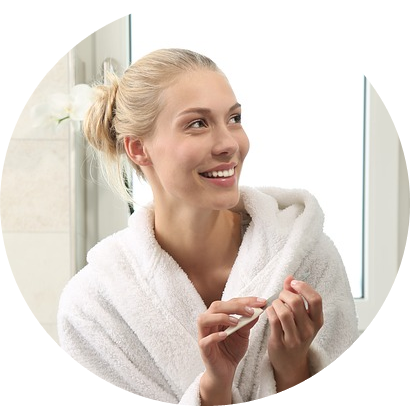Hair Loss and the Hormonal Imbalance in Women
Hair loss is widely spread and we all get affected by it at some point in our life. Normally the hair goes through 3 phases: the growth phase – an anagen phase of about 3 years that dictates the hair length, the catagen phase (the stagnation phase), lasting about 2-3 weeks and the last stage, the fall, known as telogenic phase, lasting for an average of 3 months. During all this time the hair is rising from the deep layers to the surface, so the hair strands that are programmed to fall are easily snapping off. Normally 10% of the hair is in this phase. When the percentage increases, we have an abnormal hair loss.
The hormonal imbalance. What to expect.
Hormones are one of the factors influencing the way our hair looks and behaves. This is why we lose hair after pregnancy, when suffering from a thyroid disease or when stopping the estrogen medication (eg, contraceptives). A particular type of hair loss that is located in the centre of the scalp, and not diffuse, is caused by the increase in the level of male hormones.
Oestrogen imbalance in women
New mothers. The decrease in oestrogen production after birth is quite common, but this phenomenon is often temporary, and hair growth can be stimulated by vitamin formulations prescribed by the doctor. So do not worry too much if your hair is falling after giving birth. Consult your GP and make sure you get the daily vitamins and minerals necessary for your body to cope with the changes you are getting trough.
 Menopause. When the production of oestrogen is stopping – during the menopause – it creates a multitude of symptoms and disorders including hair loss. This phenomenon differs greatly from one woman to another, and any hormonal treatment that may not be well-dosed to prevent this shortcoming needs to be quickly remedied. In this case, you should check the treatment with your GP, adjusting the initial dose. In addition to hormonal treatment, your doctor can also prescribe a local lotion or vitamins to help with the hair loss.
Menopause. When the production of oestrogen is stopping – during the menopause – it creates a multitude of symptoms and disorders including hair loss. This phenomenon differs greatly from one woman to another, and any hormonal treatment that may not be well-dosed to prevent this shortcoming needs to be quickly remedied. In this case, you should check the treatment with your GP, adjusting the initial dose. In addition to hormonal treatment, your doctor can also prescribe a local lotion or vitamins to help with the hair loss.
Try the Nutrigro® Hair Food Plus Capsules. They help maintain healthy existing hair growth & follicular health for women over 35 years of age. The capsules are specifically designed for women that are approaching certain phases of life such as menopause or post-pregnancy where there is an imbalance in Oestrogen hormone.
Thyroid problems
A slowing down of the thyroid gland causes hair loss and hair thinning. Hair becomes very dry, losing its shine, breaking easily or having split ends. The good news is that this condition is not a permanent one. This shortcoming can be remedied by thyroid hormonal treatment. Make sure you have the correct
diagnose before taking any hormonal supplements and use as much as possible natural hair loss products designed to help with hair loss and hair thinning.
Remember!
Hormonal imbalances, prolactin or cortisol imbalance can lead to hair loss. In cases of high prolactin imbalances hair loss and even the appearance of bald spots are an obvious symptom.




 Needless to say, oiling improves blood circulation and nourish the roots. Make sure to massage your tresses once a week with oil that suits your scalp. Cover it with a shower cap and wash it off with a mild shampoo after two hours.
Needless to say, oiling improves blood circulation and nourish the roots. Make sure to massage your tresses once a week with oil that suits your scalp. Cover it with a shower cap and wash it off with a mild shampoo after two hours. remove split ends.
remove split ends.

 Some fruits and vegetables have phytoestrogens – plant chemicals that are very similar in structure to oestrogen, and may act as weak oestrogen in our bodies. The mineral boron holds the body’s ability to hold onto oestrogen. Eat more plums, prunes, strawberries, apples, tomatoes, pears, grapes, broccoli, carrots, cauliflower, lettuce, and onions.
Some fruits and vegetables have phytoestrogens – plant chemicals that are very similar in structure to oestrogen, and may act as weak oestrogen in our bodies. The mineral boron holds the body’s ability to hold onto oestrogen. Eat more plums, prunes, strawberries, apples, tomatoes, pears, grapes, broccoli, carrots, cauliflower, lettuce, and onions.















